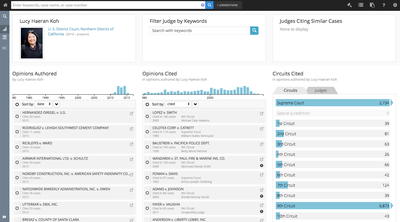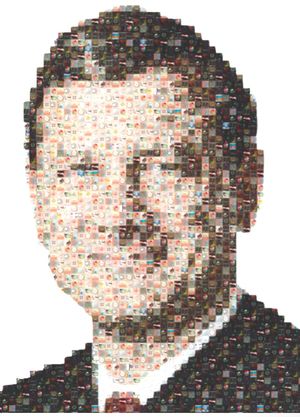By Dr. Ken Broda Bahm:
So you’re slated for trial before a judge who is new to you. Naturally, you do your due diligence and try to find out all you can on what makes this judge tick. The result? A few broad comments and stories in response to an all-firm email. If you’re lucky, you find someone who clerked for the judge. Maybe you use Lexis and Westlaw to pull up recent relevant decisions and review a few of those decisions directly. The understanding you get is partial, based only on a small sample of what that judge has done. Now, imagine you have the ability to see, on one screen, all of your judge’s published and unpublished opinions, all of the cases the judge has cited, and the language he likes to use when citing them. Imagine having access to the most common sentences and phrases the judge likes to use across different decisions. Imagine a single listing of links to all of the times the judge has been mentioned in the news and in legally-relevant blogs. That information — a “big data” approach to assessing your judge — is now available in a service called “Judge Analytics” rolled out last week by a company called Ravel Law.
The name “Ravel” is pronounced, not like the French composer of Boléro, but so as to rhyme with “gavel” — Ravel is the opposite of “unravel.” The aim of the program, as stated in a brief introductory video, is to “help you understand how a judge thinks, writes, and rules.” Through an analysis of the full text of opinions, the program highlights patterns and tells you which cases and authorities your judge finds the most influential, and “even the sentences she likes to copy and paste in her decisions.” Up to this point, Ravel’s focus has been on citation research, applying a unique method of visualizing the connections and showing the relative importance of cases, producing a graphic web of citations and subsequent and supporting decisions. That visual approach to researching precedents and case law seems like it would be incredibly useful to associates, but for partners and for litigation consultants, the new “Judge Analytics” feature might be the more interesting offering. In this post, I will take a look at some of the possibilities of this “big data” approach to audience analysis.
The Big Advantages of “Big Data”
Anytime we have access to a large quantity of digital data, aggregate forms of data mining become possible. When judge’s decisions were only in dusty bound volumes of the law library, the main way to learn about them was to directly read each one. That is theoretically possible, but too time-consuming in practice, particularly in a field that bills by the hour. In a useful webinar Ravel used to announce Judge Analytics, Jean O’Grady, the Director of Research Services and Libraries at DLA Paper, suggests a label for the new form of learning made possible by the tool: “Precedential Behavior Analysis.” As pointed out in the video, Judge Analytics offers a chance to bring “big data” (the systematic and technological analysis of vast stores of digital information) to the law. Just as political campaigns now focus much more on big data than on intuition, advisors, or gurus, law can do the same, particularly when it comes to analyzing active judges who are producing a steady stream of rulings and opinions. As Ravel notes, “This is a new era of data-driven lawyering.” O’Grady adds, “I actually think we are tipping into a new level of innovation…a revolution in analytics that will have a huge impact on the way legal research is performed and the way lawyers plan their litigation strategies.”
Ravel’s Judge Analytics: How it Works
The idea is a fascinating one, just based on its origin. The team that developed Ravel — both the visual research approach as well as the Judge Analytics — came from Stanford University’s CodeX, which is an interdisciplinary program combining computer science, law, and design. The programming part relies on something called “natural language processing,” which is the relatively new technology that makes it possible for Siri or the customer-service center robot to (usually) understand you. Applying that logic to the big data task of sifting through all a judge’s opinions and references, the team noticed that several phrases kept appearing over and over again. Co-founder and CEO Daniel Lewis, quoted in a TechCrunch profile, thought “there may be a bug in the system.” Instead, they found that judges were “just copying the sentences when they wrote their opinions,” and that opened their eyes to some broad and reliable patterns as judges interpreted the law and applied prior opinions.
 The way Ravel’s Judge Analytics works is that you enter a judge’s name and the program shows you the published and unpublished opinions authored by the judge, as well as the opinions cited by the judge. You can then filter those results by key words in order to dig down into the specifics. In the webinar, Lewis uses the example of patent litigation, noting that litigators would want to know whether a given judge has a scientific background, whether they have displayed a pro- or anti-patentee bias in their rulings, and the cases and specific sentences they rely on when ruling on particular issues. The program also relies on a selective search of those regions of the internet that are most relevant to lawyers in order to share whether the judge has been mentioned in the news or in legal blogs.
The way Ravel’s Judge Analytics works is that you enter a judge’s name and the program shows you the published and unpublished opinions authored by the judge, as well as the opinions cited by the judge. You can then filter those results by key words in order to dig down into the specifics. In the webinar, Lewis uses the example of patent litigation, noting that litigators would want to know whether a given judge has a scientific background, whether they have displayed a pro- or anti-patentee bias in their rulings, and the cases and specific sentences they rely on when ruling on particular issues. The program also relies on a selective search of those regions of the internet that are most relevant to lawyers in order to share whether the judge has been mentioned in the news or in legal blogs.
Why Ravel’s Judge Analytics is Worth Checking Out
I spoke to the specialists in my own firm’s library, and the main difference between what Ravel does and what other sources do — Westlaw, Lexis, Thomson Reuters’ Monitor Suite — is that Ravel analyzes and retrieves the specific language from the opinions. That is the feature that makes all the difference in allowing actual analytics and not just retrieval. Ravel makes it easier, for example, to use the exact language that the judge used when citing the same opinion. While it may be physically possible to locate and read all of a judge’s opinions, clients don’t typically want to pay for an associate to do that. Ravel makes it possible to hone in on the language that you are most interested in from the outset.
At present, Ravel’s Judge Analytics includes Federal Supreme, Circuit, and District Courts. It is not yet extended to state court judges, but these jurisdictions, along with some other updates, are presently in the works. As of now, Judge Analytics is only bundled with Ravel’s “Premium” service, and not available as part of the 7-day trial membership that gives one easy access to the case research tools. The company would be well advised to offer a trial membership that would allow attorneys and consultants to test out the Judge Analytics features in practice.
But from the early indications, the broad textual analysis of your judge’s rulings seems to be far more promising than either a case-by-case reading or a reliance on anecdotes.
Disclaimer:
Note: In this blog, I will occasionally look at litigation-related products and services, and I’ve given both good and bad assessments. It should go without saying, but these days it doesn’t: This is an independent article. I’ve received nothing for it, and I have no relationship – business, personal, or otherwise – with Ravel Law or the creators of Judge Analytics.
______
Other Posts on Adopting to Your Judge:
- Leading Motives and Trailing Personal Stories: Lessons in Jeffrey Toobin’s “The Oath”
- Practice the “Three P’s” of Oral Argument: The Example of Paul Clement
- Ethos, Pathos, and Logos: Use All Three in Your Legal Writing and Oral Argument
Image Credit: Courtesy of Ravel Law
